Involvement of Road Users from the Productive Age Group in Traffic Crashes in Saudi Arabia: An Investigative Study Using Statistical and Machine Learning Techniques
Abstract
1. Introduction
2. Literature Review
3. Study Area and Data Sources
Modeling Techniques
4. Analysis and Results
4.1. Trends in RTCs
4.2. Prediction Models
4.3. Comparison
5. Conclusions
Author Contributions
Funding
Institutional Review Board Statement
Informed Consent Statement
Data Availability Statement
Acknowledgments
Conflicts of Interest
Appendix A
| Crash ID | Crash Date- Day | Crash Date- Month | Crash Date- Year | Crash Severity ID | Crash Type ID | Crash Reason ID | Number of Deaths | Number of Injuries Major |
|---|---|---|---|---|---|---|---|---|
| 1 | 9 | 11 | 1436 | 2 | 1 | 14 | 1 | |
| 2 | 6 | 6 | 1436 | 1 | 1 | 15 | 1 | 5 |
| 3 | 27 | 4 | 1436 | 1 | 9 | 14 | 1 | |
| 4 | 6 | 2 | 1436 | 2 | 1 | 4 | 3 | |
| 5 | 16 | 3 | 1437 | 1 | 1 | 15 | 4 | 46 |
| 6 | 6 | 2 | 1436 | 2 | 1 | 4 | 2 | |
| 7 | 2 | 1 | 1436 | 2 | 9 | 14 | 2 | |
| 8 | 15 | 2 | 1436 | 2 | 1 | 14 | 1 | |
| 9 | 16 | 2 | 1436 | 1 | 1 | 4 | 2 | 1 |
| 10 | 20 | 2 | 1436 | 9 | 14 | 1 | ||
| 11 | 23 | 1 | 1437 | 2 | 1 | 4 | 1 | |
| 12 | 8 | 5 | 1436 | 1 | 1 | 15 | 1 | 1 |
| 13 | 5 | 4 | 1436 | 1 | 1 | 4 | 1 | 2 |
References
- Ackaah, W.; Adonteng, D.O. Analysis of Fatal Road Traffic Crashes in Ghana. Int. J. Inj. Control Saf. Promot. 2011, 18, 21–27. [Google Scholar] [CrossRef] [PubMed]
- Factor, R. The Effect of Traffic Tickets on Road Traffic Crashes. Accid. Anal. Prev. 2014, 64, 86–91. [Google Scholar] [CrossRef] [PubMed]
- Ang, J.Y.; Gabbe, B.; Cameron, P.; Beck, B. Animal–Vehicle Collisions in Victoria, Australia: An under-Recognised Cause of Road Traffic Crashes. EMA Emerg. Med. Australas. 2019, 31, 851–855. [Google Scholar] [CrossRef]
- Basu, S.; Saha, P. Regression Models of Highway Traffic Crashes: A Review of Recent Research and Future Research Needs. Procedia Eng. 2017, 187, 59–66. [Google Scholar] [CrossRef]
- Elvik, R. Risk of Road Accident Associated with the Use of Drugs: A Systematic Review and Meta-Analysis Of Evidence from Epidemiological Studies. Accid. Anal. Prev. 2013, 60, 254–267. [Google Scholar] [CrossRef]
- Kaygisiz, Ö.; Yildiz, A.; Düzgün, Ş. Spatio-Temporal Pedestrian Accident Analysis to Improve Urban Pedestrian Safety: The Case of the Eskişehir Motorway. Gazi Univ. J. Sci. 2015, 28, 623–630. [Google Scholar]
- MORT&H. Road Accidents Data. 2010. Available online: https://morth.nic.in/sites/default/files/Road_Accidents_in_India_2010.pdf (accessed on 5 May 2022).
- Nantuly, V.M.; Muli-Musiime, F. Kenya: Uncovering the Social Determinants of Road Traffic Accidents. In Challenging Inequities in Health: From Ethics to Action; Oxford University Press: Oxford, UK, 2009. [Google Scholar] [CrossRef]
- Hijaar, M.C. Traffic Injuries in Latin American and the Caribbean Countries. 1999. Available online: www.globalforumhealth.org/Non_compliant_pages/forum3/Forum3doc962.htm (accessed on 20 June 2006).
- LaScala, E.A.; Gerber, D.; Gruenewald, P.J. Demographic and Environmental Correlates of Pedestrian Injury Collisions: A Spatial Analysis. Accid. Anal. Prev. 2000, 32, 651–658. [Google Scholar] [CrossRef]
- Mungnimit, S. Road Traffic Accident Losses; Transport and Communications Policy and Planning Bureau, Ministry of Transport and Communications: Bangkok, Thailand, 2001.
- Bener, A. The Neglected Epidemic: Road Traffic Accidents in a Developing Country, State of Qatar. Int. J. Inj. Control Saf. Promot. 2005, 12, 45–47. [Google Scholar] [CrossRef]
- Wedagama, D.M.P.; Dissanayake, D. The Influence of Accident Related Factors on Road Fatalities Considering Bali Province in Indonesia as a Case Study. J. East. Asia Soc. Transp. Stud. 2010, 8, 905–1917. [Google Scholar] [CrossRef]
- Ishrat, R. Global Status Report on Road Safety 2018: Summary; World Health Organization: Geneva, Switzerland, 2018.
- Scholes, S.; Wardlaw, M.; Anciaes, P.; Heydecker, B.; Mindell, J.S. Fatality Rates Associated with Driving and Cycling for All Road Users in Great Britain 2005–2013. J. Transp. Health 2018, 8, 321–333. [Google Scholar] [CrossRef]
- Abegaz, T.; Gebremedhin, S. Magnitude of Road Traffic Accident Related Injuries and Fatalities in Ethiopia. PLoS ONE 2019, 14, e0202240. [Google Scholar] [CrossRef] [PubMed]
- Peden, M. Injury: A Leading Cause of the Global Burden of Disease, 2000; Department of Injuries and Violence Prevention Noncommunicable Diseases and Mental Health Cluster World Health Organization: Geneva, Switzerland, 2002. Available online: http://www.worldcat.org/title/injury-a-leading-cause-of-the-global-burden-of-disease-2000/oclc/52416791?tab=details (accessed on 21 September 2011). [CrossRef]
- Cataldi, A.; Kampelmann, S.; Rycx, F. Does It Pay to be Productive? The Case of Age Groups. Int. J. Manpow. 2012, 33, 264–283. [Google Scholar] [CrossRef][Green Version]
- Sanyang, E.; Peek-Asa, C.; Bass, P.; Young, T.L.; Daffeh, B.; Fuortes, L.J. Risk Factors for Road Traffic Injuries among Different Road Users in the Gambia. J. Environ. Public Health 2017, 2017, 8612953. [Google Scholar] [CrossRef] [PubMed]
- Useche, S.A.; Montoro, L.; Sanmartin, J.; Alonso, F. Healthy but Risky: A Descriptive Study on Cyclists’ Encouraging and Discouraging Factors for Using Bicycles, Habits and Safety Outcomes. Transp. Res. Part F Traffic Psychol. Behav. 2019, 62, 587–598. [Google Scholar] [CrossRef]
- Lee, J.; Abdel-Aty, A.; Park, J. Investigation of Associations between Marijuana Law Changes and Marijuana-Involved Fatal Traffic Crashes: A State-Level Analysis. J. Transp. Health 2018, 10, 194–202. [Google Scholar] [CrossRef]
- Wang, D.; Liu, Q.; Ma, L.; Zhang, Y.; Cong, H. Road Traffic Accident Severity Analysis: A Census-Based Study in China. J. Saf. Res. 2019, 70, 135–147. [Google Scholar] [CrossRef]
- Damsere-Derry, J.; Palk, G.; King, M. Road accident Fatality Risks for ‘Vulnerable’ Versus ‘Protected’ Road Users in Northern Ghana. Traffic Inj. Prev. 2017, 18, 736–743. [Google Scholar] [CrossRef]
- Bjerre, J.; Kirkebjerg, P.G.; Larsen, L.B. Prevention of Traffic Deaths in Accidents Involving Motor Vehicles. Ugeskr Laeger 2006, 168, 1764–1768. [Google Scholar]
- Smart, R.G.; Mann, R.E. Deaths and Injuries from Road Rage: Cases in Canadian Newspapers. Can. Med. Assoc. J. 2002, 167, 761–762. [Google Scholar]
- Touahmia, M. Identification of Risk Factors Influencing Road Traffic Accidents. Eng. Technol. Appl. Sci. Res. 2018, 8, 2417–2421. [Google Scholar] [CrossRef]
- Jonah, B.A. Accident Risk and Risk-Taking Behaviour Among Young Drivers. Accid. Anal. Prev. 1986, 18, 255–271. [Google Scholar] [CrossRef]
- Doherty, S.T.; Andrey, J.C.; Macgregor, C. The Situational Risks of Young Drivers: The Influence of Passengers, Time of Day and Day of Week on Accident Rates. Accid. Anal. Prev. 1998, 30, 45–52. [Google Scholar] [CrossRef]
- Chliaoutakis, J.E.; Darviri, C.; Demakakos, P.T. The Impact of Young Drivers ’ Lifestyle on Their Road Traffic Accident Risk in Greater Athens Area. Accid. Anal. Prev. 1999, 31, 771–780. [Google Scholar] [CrossRef]
- Chen, H.Y.; Senserrick, T.; Chang, H.Y.; Ivers, R.Q.; Martiniuk, A.; Boufous, S.; Norton, R. Road Crash Trends for Young Drivers in New South Wales, Australia, from 1997 to 2007. Traffic Inj. Prev. 2010, 11, 8–15. [Google Scholar] [CrossRef]
- Al-hemoud, A.M.; Simmons, R.J.; Al-asfoor, M.M. Behavior and Lifestyle Characteristics of Male Kuwaiti Drivers. J. Saf. Res. 2010, 41, 307–313. [Google Scholar] [CrossRef]
- Simons-Morton, B.G.; Ouimet, M.C.; Chen, R.; Klauer, S.G.; Lee, S.E.; Wang, J.; Dingus, T.A. Peer Influence Predicts Speeding Prevalence among Teenage Drivers. J. Saf. Res. 2012, 43, 397–403. [Google Scholar] [CrossRef]
- Carpentier, A.; Brijs, K.; Declercq, K.; Brijs, T.; Daniels, S. The Effect of Family Climate on Risky Driving of Young Novices: The Moderating Role of Attitude and Locus of Control. Accid. Anal. Prev. 2014, 73, 53–64. [Google Scholar] [CrossRef]
- Hassan, H.M. Investigation of the Self-Reported Aberrant Driving Behavior of Young Male Saudi Drivers: A Survey-Based Study. J. Transp. Saf. Secur. 2016, 8, 113–128. [Google Scholar] [CrossRef]
- Ramisetty-Mikler, S.; Almakadma, A. Attitudes and Behaviors Towards Risky Driving among Adolescents in Saudi Arabia. Int. J. Pediatr. Adolesc. Med. 2016, 3, 55–63. [Google Scholar] [CrossRef]
- Issa, Y. Effect of Driver’s Personal Characteristics on Traffic Accidents in Tabuk city in Saudi Arabia. J. Transp. Lit. 2016, 10, 25–29. [Google Scholar] [CrossRef]
- Mohamed, M.; Bromfield, N.F. Attitudes, Driving Behavior, and Accident Involvement among Young Male Drivers in Saudi Arabia. Transp. Res. Part F Psychol. Behav. 2017, 47, 59–71. [Google Scholar] [CrossRef]
- Weston, L.; Hellier, E. Designing Road Safety Interventions for Young Drivers: The Power of Peer Influence. Transp. Res. Part F Traffic Psychol. Behav. 2018, 55, 262–271. [Google Scholar] [CrossRef]
- Zeyin, Y.; Long, S.; Gaoxiao, R. Effects of Safe Driving Climate among Friends on Prosocial and Aggressive Driving Behaviors of Young Drivers: The Moderating Role of Traffic Locus of Control. J. Saf. Res. 2022, 81, 297–304. [Google Scholar] [CrossRef] [PubMed]
- Zhu, S. Analyse Vehicle–Pedestrian Crash Severity at Intersection with Data Mining Techniques. Int. J. Crashworthiness 2021, 1–9. [Google Scholar] [CrossRef]
- Saha, D.; Dumbaugh, E. Use of a Model-Based Gradient Boosting Framework to Assess Spatial and Non-Linear Effects of Variables on Pedestrian Crash Frequency at Macro-Level. J. Transp. Saf. Secur. 2021, 1–32. [Google Scholar] [CrossRef]
- Guo, M.; Yuan, Z.; Janson, B.; Peng, Y.; Yang, Y.; Wang, W. Older Pedestrian Traffic Crashes Severity Analysis Based on an Emerging Machine Learning Xgboost. Sustainability 2021, 13, 926. [Google Scholar] [CrossRef]
- Tao, W.; Aghaabbasi, M.; Almaliki, A.H.; Zainol, R.; Almaliki, A.A.; Hussein, E.E. An Advanced Machine Learning Approach to Predicting Pedestrian Fatality Caused by Road Crashes: A Step toward Sustainable Pedestrian Safety. Sustainability 2022, 14, 2436. [Google Scholar] [CrossRef]
- Pour, A.T.; Moridpour, S.; Rajabifard, A.; Tay, R. Spatial and temporal Distribution of Pedestrian Crashes in Melbourne Metropolitan Area. Road Transp. Res. 2017, 26, 4–20. [Google Scholar]
- Ding, C.; Chen, P.; Jiao, J. Non-Linear Effects of the Built Environment on Automobile-Involved Pedestrian Crash Fre-quency: A Machine Learning Approach. Accid. Anal. Prev. 2018, 112, 116–126. [Google Scholar] [CrossRef]
- Mokhtarimousavi, S. A Time of Day Analysis of Pedestrian-Involved Crashes in California: Investigation of Injury Severity, A Logistic Regression and Machine Learning Approach using HSIS data. ITE J.-Inst. Transp. Eng. 2019, 89, 25–33. [Google Scholar]
- Zou, Y.; Ding, L.; Zhang, H.; Zhu, T.; Wu, L. Vehicle Acceleration Prediction Based on Machine Learning Models and Driving Behavior Analysis. Appl. Sci. 2022, 12, 5259. [Google Scholar] [CrossRef]
- Mansuri, F.A.; Al-Zalabani, A.H.; Zalat, M.M.; Qabshawi, R.I. Road Safety and Road Traffic Accidents in Saudi Arabia: A Systematic Review of Existing Evidence. Saudi Med. J. 2015, 36, 418–424. [Google Scholar] [CrossRef] [PubMed]
- Al-Garawi, N.; Dalhat, M.A.; Aga, O. Assessing the road Traffic Crashes among Novice Female Drivers in Saudi Arabia. Sustainability 2021, 13, 8613. [Google Scholar] [CrossRef]
- Jamal, A.; Rahman, M.T.; Al-Ahmadi, H.M.; Mansoor, U. The Dilemma of Road Safety in the Eastern Province of Saudi Arabia: Consequences and Prevention Strategies. Int. J. Environ. Res. Public Health 2020, 17, 157. [Google Scholar] [CrossRef]
- Rahman, M.M.; Islam, M.K.; Al-Shayeb, A.; Arifuzzaman, M. Towards Sustainable Road Safety in Saudi Arabia: Exploring Traffic Accident Causes Associated with Driving Behavior Using a Bayesian Belief Network. Sustainability 2022, 14, 6315. [Google Scholar] [CrossRef]
- Fiorentini, N.; Losa, M. Handling Imbalanced Data in Road Crash Severity Prediction by Machine Learning Algorithms. Infrastructures 2020, 5, 61. [Google Scholar] [CrossRef]
- Jeong, H.; Jang, Y.; Bowman, P.J.; Masoud, N. Classification of Motor Vehicle Crash Injury Severity: A Hybrid Approach for Imbalanced Data. Accid. Anal. Prev. 2018, 120, 250–261. [Google Scholar] [CrossRef]
- Flach, P. Machine Learning: The Art and Science of Algorithms that Make Sense of Data; Cambridge University of Press: Cambridge, UK, 2012. [Google Scholar]
- Wahab, L.; Jiang, H. A Comparative Study on Machine Learning Based Algorithms for Prediction of Motorcycle Crash Severity. PLoS ONE 2019, 14, e0214966. [Google Scholar] [CrossRef]
- Almoshaogeh, M.; Abdulrehman, R.; Haider, H.; Alharbi, F.; Jamal, A.; Alarifi, S.; Shafiquzzaman, M. Traffic Accident Risk Assessment Framework for Qassim, Saudi Arabia: Evaluating the Impact of Speed Cameras. Appl. Sci. 2021, 11, 6682. [Google Scholar] [CrossRef]
- Lepa, S. Statistical Significance: Testing. In The International Encyclopedia of Media Psychology; John Wiley & Sons, Inc.: Hoboken, NJ, USA, 2020; pp. 1–1111. [Google Scholar]
- City-Fact. Available online: https://www.city-facts.com/al-ahsa (accessed on 5 May 2022).
- Liu, C.; Sharma, A. Exploring Spatio-Temporal Effects in Traffic Crash Trend Analysis. Anal. Methods Accid. Res. 2017, 16, 104–116. [Google Scholar] [CrossRef]
- Arévalo-Támara, A.A.; Fontalvo, M.O.; Cantillo, V. Factors Influencing Crash Frequency on Colombian Rural Roads. Promet Traffic Transp. 2020, 32, 449–460. [Google Scholar] [CrossRef]
- Bassani, M.; Rossetti, L.; Catani, L. Spatial Analysis of Road Crashes Involving Vulnerable Road Users in Support of Road Safety Management Strategies. Transp. Res. Procedia 2020, 45, 394–401. [Google Scholar] [CrossRef]
- Abdi, T.A.; Hailu, B.H.; Adal, T.A.; Van Gelder, P.H.A.J.M.; Hagenzieker, M.P.; Carbon, C.-C. Road Crashes in Addis Ababa, Ethiopia: Empirical Findings between the Years 2010 and 2014. Afr. Res. Rev. 2017, 11, 2. [Google Scholar] [CrossRef]
- Bener, A.; Rahman, Y.S.A.; Mitra, B. Incidence and Severity of Head and Neck Injuries in Victims of Road Traffic Crashes: In an Economically Developed Country. Int. Emerg. Nurs. 2009, 17, 52–59. [Google Scholar] [CrossRef] [PubMed]
- Mondal, P. A Silent Tsunami on Indian Road: A Comprehensive Analysis of Epidemiological Aspects of Road Traffic Accidents. Br. J. Med. Med. Res. 2011, 1, 14–23. [Google Scholar] [CrossRef][Green Version]
- Goutte, C.; Gaussier, E. A Probabilistic Interpretation of Precision, Recall and F-Score, with Implication for Evaluation. In Proceedings of the European Conference on Information Retrieval, Santiago de Compostela, Spain, 21–23 March 2005. [Google Scholar] [CrossRef]
- Medjahed, S.A. A Comparative Study of Feature Extraction Methods in Images Classification. Int. J. Image Graph. Signal Process. 2015, 7, 16. [Google Scholar] [CrossRef]
- Sisodia, D.; Sisodia, D.S. Science Direct Prediction of Diabetes using Classification Algorithms. Procedia Comput. Sci. 2018, 132, 1578–1585. [Google Scholar] [CrossRef]
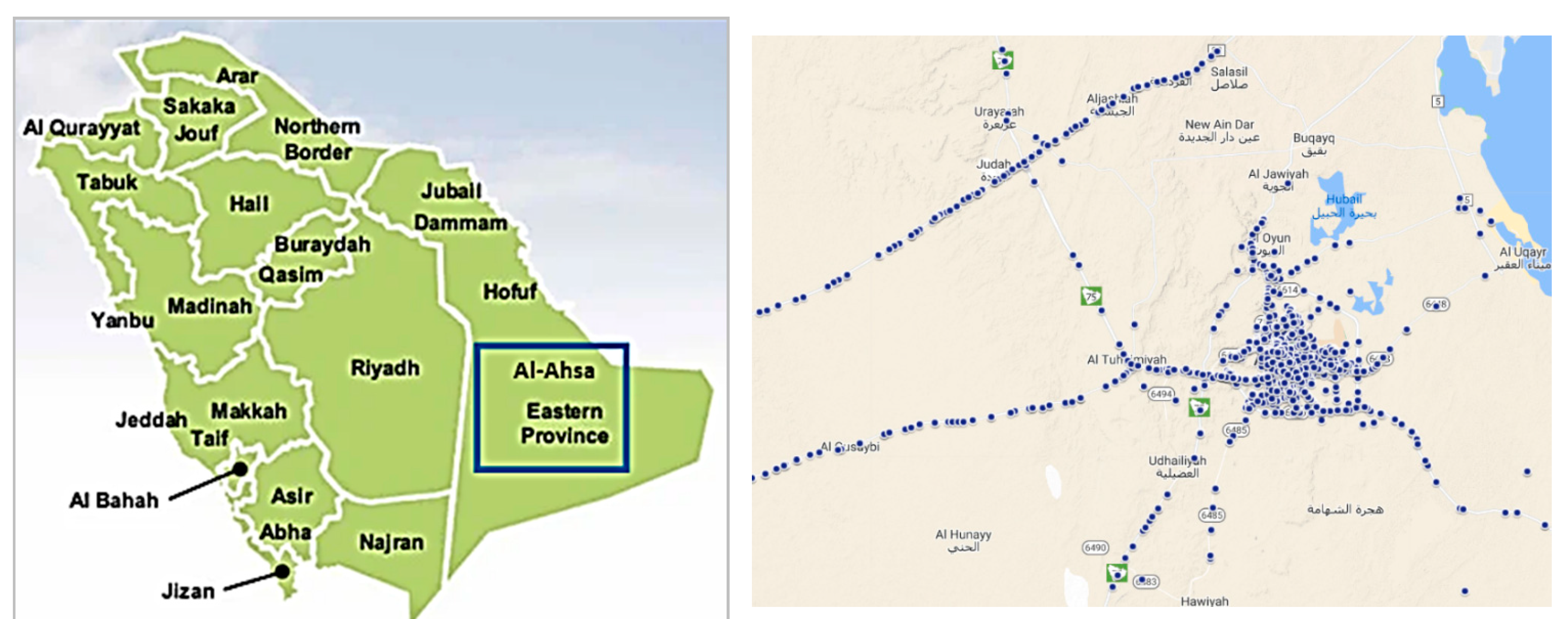

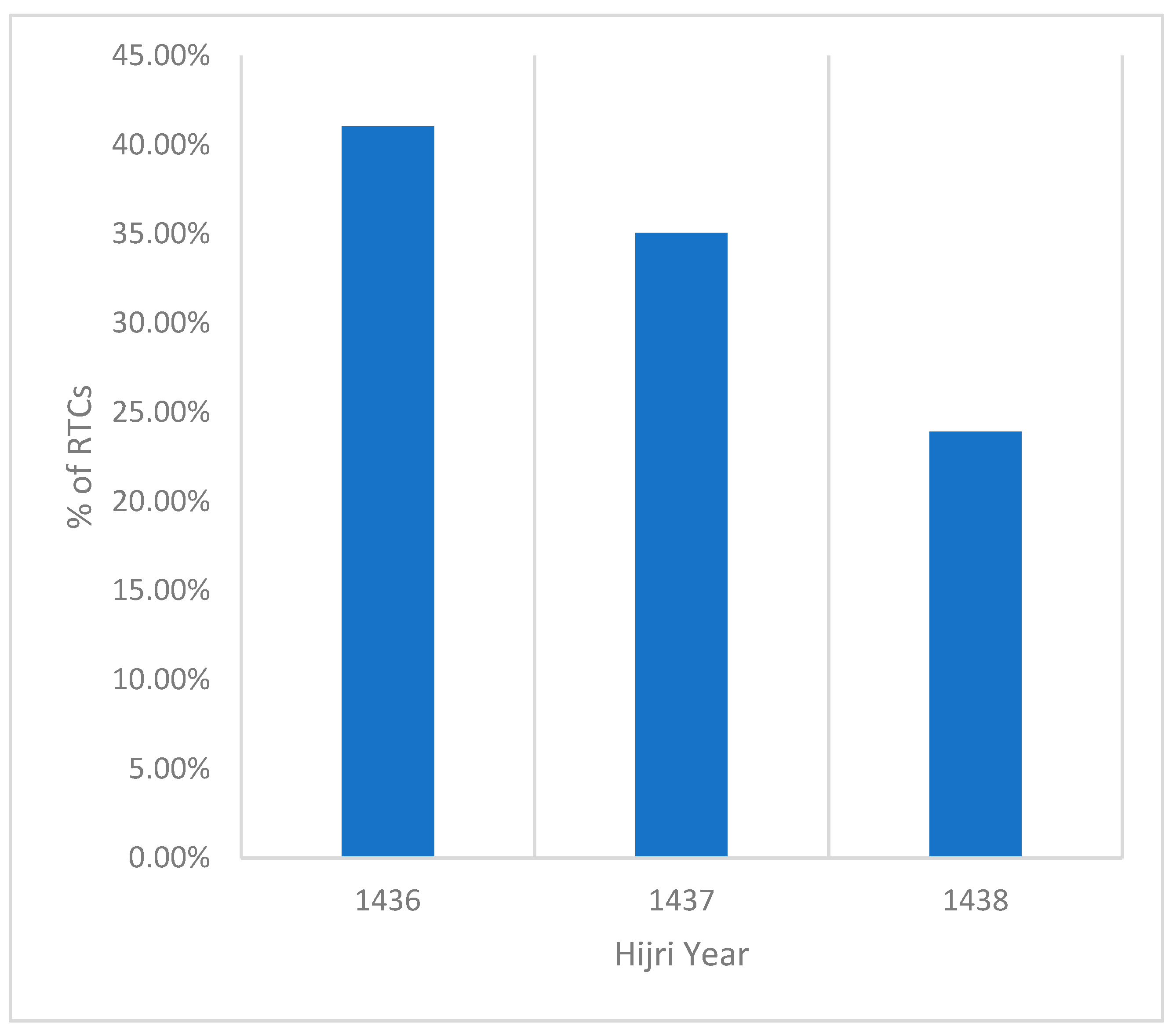

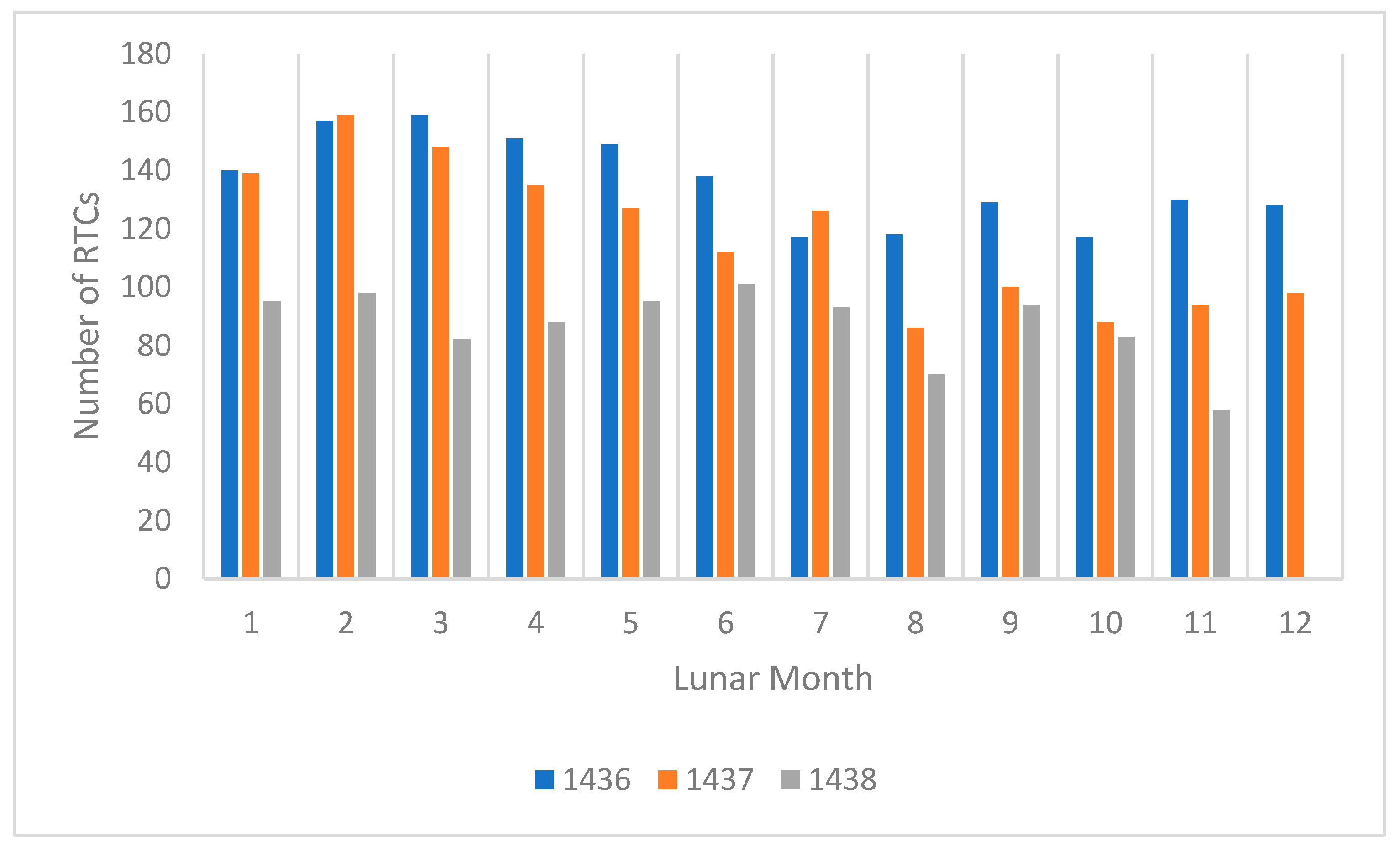
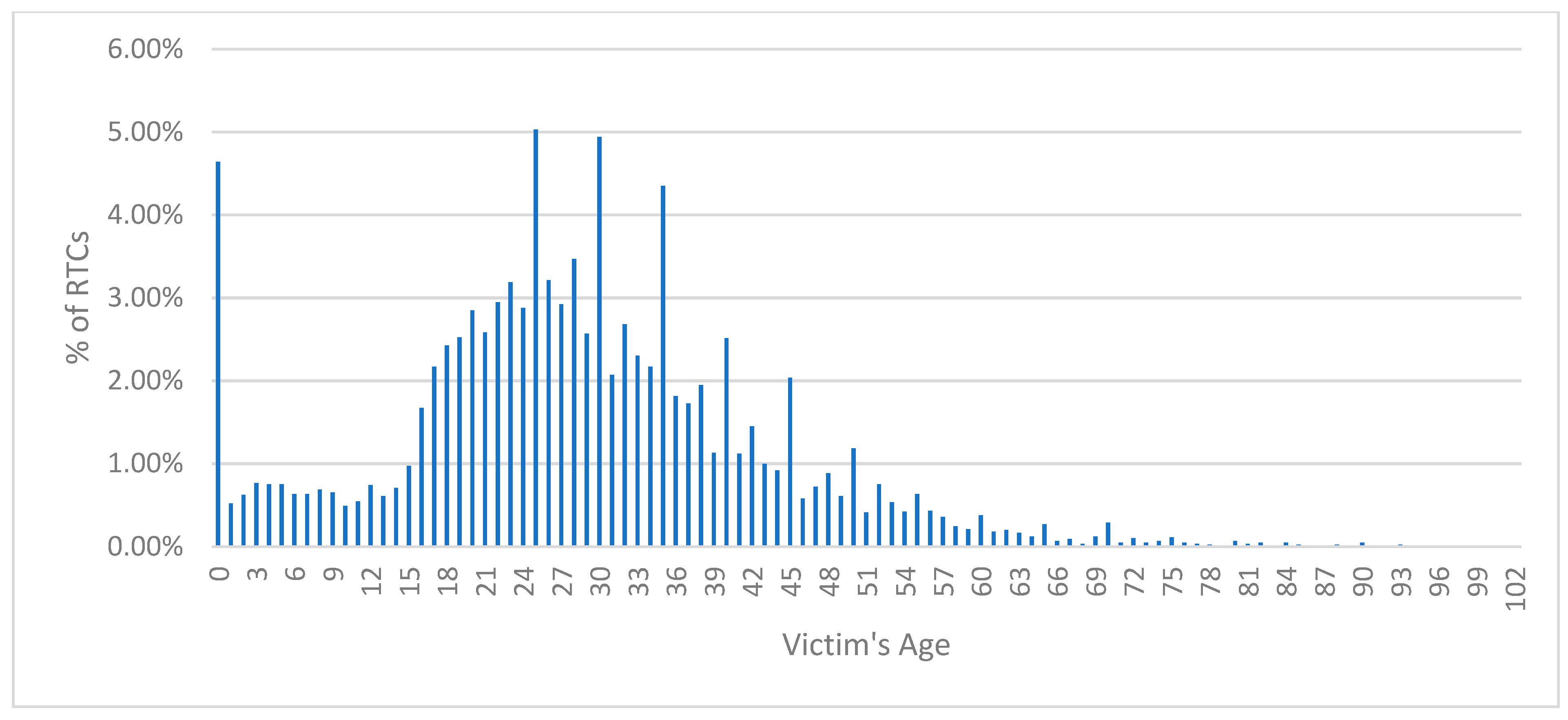
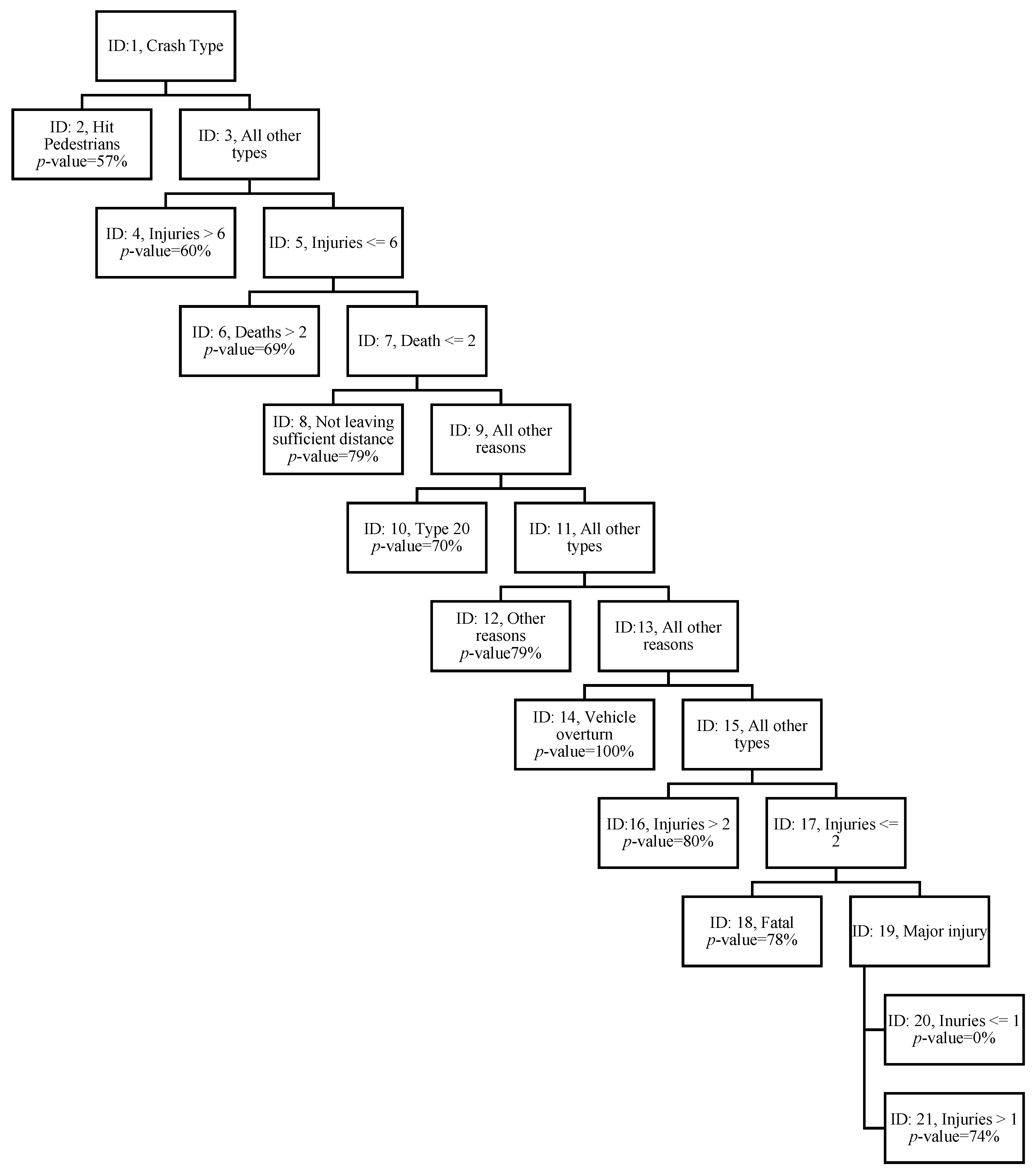

| References | Focus Group | City/Country | Comments |
|---|---|---|---|
| Brian A. Jonah [27] | 16–25 years | Canada | Successfully tested two hypotheses: (a) young drivers are more likely to be involved in a fatal crash than older drivers and (b) that this higher risk is mostly due to their tendency to take risks when driving. |
| Sean T. Doherty et al. [28] | 16–19 years, 20–24 years, 25–59 years | Ontario, Canada | Studied the situational dangers that young drivers of different age groups face. Crash rate for the 16–19-year-old age group was higher than other age groups. The rate of traffic crashes was even higher on weekends and nights. |
| Joannes El. Chliaoutakis et al. [29] | 18–24 years | Greece | Investigated the potential relationship between the lifestyle of teenage drivers and their chances of becoming involved in a traffic crash using factor analysis and logistic regression analysis. |
| H. Y. Chen et al. [30] | 17–25 years | NSW, Australia | Examined passenger vehicle crash pattern over time by severity of driver injury considering age, gender, rurality of location, and socioeconomic position. Drives aged 17–20 years had significantly and continuously greater risk than drivers aged 21–25 years old. |
| Al-Hemoud et al. [31] | 25–35 years | Kuwait | Examined the relation between living style and crash risk-taking behavior of drivers. |
| Bruce G.Simons-Morton et al. [32] | Teen ages | Virginia Metropolitan Area, USA | Investigated psychological and personality variables of observed speeding. The relationship between speeding and risk-taking friends was significantly mediated by perceived danger. |
| Aline Carpentier [33] | 17–24 years | Hasselt, Belgium | Studied the influence of family environment and socio-cognitive elements on driving behavior on young novice drivers; both family environment and socio-cognitive variables were predicted to have a direct impact on hazardous driving. |
| Hassan [34] | 18–24 years | Riyadh, Saudi Arabia | Studied the factors that affect the involvement of young Saudi motorists in traffic crashes, where findings revealed that more than 70% of penalties and 60% of risky driving were due to exceeding the posted speed limit and “being late”, respectively. |
| Ramisetty-Mikler and Almakadma [35] | Teen age | Riyadh, Saudi Arabia | Conducted a survey on teenage drivers, where it was found that 40% of drivers “drift” cars as an act of adventure despite knowing that it is a hazardous action. |
| Issa [36] | Below 30 years | Tabuk, Saudi Arabia | Showed that experienced and educated drivers were more involved in RTCs than less experienced and educated drivers. |
| Mohamed and Bromfield [37] | 18–24 years | Eastern Province, Saudi Arabia | Young Saudi male drivers were divided into three categories: (i) error-making, (ii) aggressive, and (iii) negligent. |
| Lauren Weston and Elizabeth Hellier [38] | Teen age | USA | Studied the relationship between peer influence vulnerability and unsafe driving behavior and suggested peer education tools for safe driving. |
| Yang Zeyin et al. [39] | 18–25 years | China | Investigated the influence of a safe driving environment among friends on prosocial and aggressive driving behavior. |
| Sum of Squares | Degrees of Freedom | Mean Sum of Squares | F-Value | p-Value | |
|---|---|---|---|---|---|
| Intercept | 444,889 | 1 | 444,889 | 407 | 0.00 |
| Month | 11,496 | 11 | 1045 | 0.95 | 0.51 |
| Error | 26,239 | 24 | 1093 |
| Parameter | Number of Major Injuries | Number of Deaths |
|---|---|---|
| Total | 22,787 | 3579 |
| Number of RTCs | 3245 | 756 |
| Average per RTC * | 7 | 4 |
| Range | 0–46 | 0–13 |
| Severity Index = deaths/no. of RTCs | 0.89 | |
| Number of fatal and major injury RTCs per year | 1333 | |
| Number of fatal RTCs per year | 352 | |
| Number of deaths per year | 1193 | |
| Number of deaths per 100,000 people | 311 | |
| Parameter | Classes | Description/Code |
|---|---|---|
| Severity | Fatal | 1 |
| Major injury | 2 | |
| Crash type | Collision | 1 |
| Hit motorcycle | 3 | |
| Hit road fence | 6 | |
| Hit pedestrians | 8 | |
| Vehicle overturn | 9 | |
| Other types | 20 | |
| Crash reason | Driver distraction | 3 |
| Speeding | 4 | |
| Not giving way | 9 | |
| Sudden turning | 14 | |
| Not leaving sufficient distance | 15 | |
| Other reasons | 46 | |
| Number of deaths | N/A | Number of persons killed in RTC |
| Number of injuries | N/A | Number of persons injured in RTC |
| Age | 15 to 44 (inclusive) | 1 |
| Less than 15 or more than 44 | 0 |
| Variable | t-Statistic | p-Value |
|---|---|---|
| Intercept | −19.26 | 0.00 |
| Fatal | 2.25 | 0.02 |
| Collision | −2.78 | 0.01 |
| Vehicle overturn | 0.15 | 0.88 |
| Hit pedestrians | 7.46 | 0.00 |
| Other types | −1.08 | 0.28 |
| Hit road fence | −0.02 | 0.98 |
| Not leaving sufficient gap | −3.16 | 0.00 |
| Sudden turning | −3.35 | 0.00 |
| Speeding | 0.57 | 0.57 |
| Not giving way | 3.12 | 0.00 |
| Other reasons | 1.64 | 0.10 |
| Number of injuries | 5.45 | 0.00 |
| Variable | t-Statistic | p-Value |
|---|---|---|
| Intercept | −19.26 | 0.00 |
| Hit pedestrians | 2.25 | 0.02 |
| Not leaving sufficient gap | −2.78 | 0.01 |
| Number of injuries | 0.15 | 0.88 |
| Fatal | 7.46 | 0.00 |
| Parameter | Dataset | Value |
|---|---|---|
| Accuracy | Development | 0.73 |
| Validation | 0.73 | |
| Precision | Development | 0.74 |
| Validation | 0.74 | |
| Recall | Development | 1.00 |
| Validation | 0.98 | |
| Error | Development | 0.27 |
| Validation | 0.27 | |
| FDR | Development | 0.26 |
| Validation | 0.26 | |
| FNR | Development | 0.00 |
| Validation | 0.02 | |
| F-1 | Development | 0.85 |
| Validation | 0.84 |
| Parameter | Dataset | Value |
|---|---|---|
| Accuracy | Development | 0.74 |
| Validation | 0.74 | |
| Precision | Development | 0.74 |
| Validation | 0.73 | |
| Recall | Development | 1 |
| Validation | 1 | |
| Error | Development | 0.26 |
| Validation | 0.26 | |
| FDR | Development | 0.26 |
| Validation | 0.27 | |
| FNR | Development | 0 |
| Validation | 0 | |
| F-1 | Development | 0.85 |
| Validation | 0.84 |
Publisher’s Note: MDPI stays neutral with regard to jurisdictional claims in published maps and institutional affiliations. |
© 2022 by the authors. Licensee MDPI, Basel, Switzerland. This article is an open access article distributed under the terms and conditions of the Creative Commons Attribution (CC BY) license (https://creativecommons.org/licenses/by/4.0/).
Share and Cite
Islam, M.K.; Gazder, U.; Akter, R.; Arifuzzaman, M. Involvement of Road Users from the Productive Age Group in Traffic Crashes in Saudi Arabia: An Investigative Study Using Statistical and Machine Learning Techniques. Appl. Sci. 2022, 12, 6368. https://doi.org/10.3390/app12136368
Islam MK, Gazder U, Akter R, Arifuzzaman M. Involvement of Road Users from the Productive Age Group in Traffic Crashes in Saudi Arabia: An Investigative Study Using Statistical and Machine Learning Techniques. Applied Sciences. 2022; 12(13):6368. https://doi.org/10.3390/app12136368
Chicago/Turabian StyleIslam, Md. Kamrul, Uneb Gazder, Rocksana Akter, and Md. Arifuzzaman. 2022. "Involvement of Road Users from the Productive Age Group in Traffic Crashes in Saudi Arabia: An Investigative Study Using Statistical and Machine Learning Techniques" Applied Sciences 12, no. 13: 6368. https://doi.org/10.3390/app12136368
APA StyleIslam, M. K., Gazder, U., Akter, R., & Arifuzzaman, M. (2022). Involvement of Road Users from the Productive Age Group in Traffic Crashes in Saudi Arabia: An Investigative Study Using Statistical and Machine Learning Techniques. Applied Sciences, 12(13), 6368. https://doi.org/10.3390/app12136368







